
Caladenia paludosa, commonly known as the swamp spider orchid, is a species of orchid endemic to the south-west of Western Australia. It has a single erect, hairy leaf and up to three red, greenish-yellow and cream-coloured flowers. It mostly grows in dense scrub and is one of the last of the similar spider orchids to flower.

Caladenia lobata, commonly known as the butterfly orchid, is a species of orchid endemic to the south-west of Western Australia. It has a single, hairy leaf and one or two greenish-yellow flowers with red markings which have a labellum which vibrates in the slightest breeze.

Caladenia crebra, commonly known as the Arrowsmith spider orchid is a species of orchid endemic to the south-west of Western Australia. It has one or two relatively large, greenish-yellow flowers whose lateral sepals have thin brown "clubs" on their ends.

Caladenia doutchiae, commonly known as the purple-veined clown orchid or purple-veined spider orchid is a species of orchid endemic to the south-west of Western Australia. It has a single hairy leaf and usually only one greenish-yellow and red flower with short, downswept petals, and lateral sepals that are broad at the base then narrow to a glandular tip.
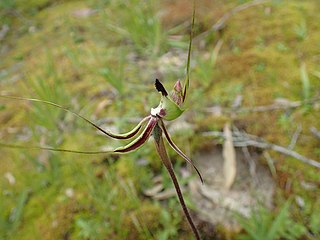
Caladenia exstans, commonly known as the pointing spider orchid, is a species of orchid endemic to a small area in the south-west of Western Australia. It has a single, hairy leaf and one or two green, yellow and red flowers with a labellum which does not curl downwards but "points" forward.
Caladenia graniticola, commonly known as the Pingaring spider orchid, is a species of orchid endemic to the south-west of Western Australia. It has a single, hairy leaf and one or two yellowish-green, red and white flowers which have a greenish-yellow and white labellum with a red tip. It was originally described as Caladenia hoffmanii subsp. graniticola but has a slightly different labellum and column.
Caladenia heberleana, commonly known as Heberle's spider orchid, is a species of orchid endemic to the south-west of Western Australia. It has a single, hairy leaf and up to three red, white and pale yellow flowers which have a white, red-tipped labellum.
Caladenia helvina, commonly known as the summer spider orchid, is a plant in the orchid family Orchidaceae and is endemic to Tasmania. It is a ground orchid with a single hairy leaf and usually a single greenish-yellow to pale yellow flower with reddish teeth on the sides of the labellum and reddish calli along its mid-line.
Caladenia hoffmanii, commonly known as Hoffman's spider orchid is a species of orchid endemic to the south-west of Western Australia. It has a single, hairy leaf and one or two, greenish-yellow, red and white flowers which have a greenish-yellow labellum with a red tip. It is distinguished from the Pingaring spider orchid by small differences in the labellum and more northerly distribution.
Caladenia incrassata, commonly known as the puppet clown orchid is a species of orchid endemic to the south-west of Western Australia. It has a single, hairy leaf and usually only one greenish-yellow and red flower which has a red-striped labellum.
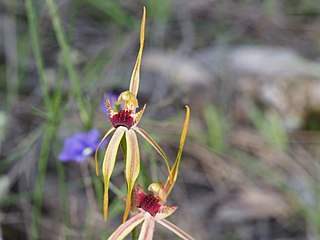
Caladenia longiclavata, commonly known as the clubbed spider orchid is a species of plant in the orchid family, Orchidaceae and is endemic to the south-west of Western Australia. It is a widespread and common orchid with a single, hairy leaf and one or two greenish-yellow, white and red flowers and which grows in the area between Perth and Albany.

Caladenia magniclavata, commonly known as big clubbed spider orchid is a species of orchid endemic to the south-west of Western Australia. It has a single, hairy leaf, and up to three pale yellow-green and red flowers with downswept, prominently clubbed sepals and petals.

Caladenia microchila, commonly known as the western wispy spider orchid, is a species of orchid endemic to the south-west of Western Australia. It is relatively common orchid with a single erect, hairy leaf and up to three wispy white flowers with narrow lateral sepals and petals and a white labellum with red markings.

Caladenia multiclavia, commonly known as the lazy spider orchid is a species of orchid, endemic to the south-west of Western Australia. It has a single, hairy leaf and one or two greenish-yellow, red and cream-coloured flowers resembling a reclining spider. Although it usually only has a single flower, it often grows in clumps of up to six plants.
Caladenia nobilis, commonly known as the noble spider orchid, is a species of orchid endemic to the south-west of Western Australia. It has a single hairy leaf and one or two large white flowers with a red-marked labellum.
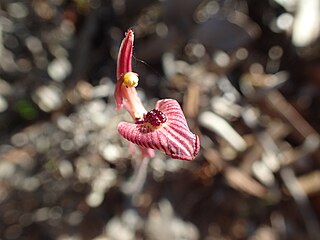
Caladenia pachychila, commonly known as the dwarf zebra orchid, is a species of orchid endemic to the south-west of Western Australia. It has a single erect, hairy leaf and one or two greenish-yellow and red flowers with a red-striped labellum which has a dense cluster of deep purple calli in its centre. It is similar to the zabra orchid but has smaller flowers and the lateral sepals do not clasp the ovary.
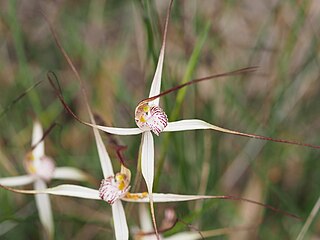
Caladenia polychroma, commonly known as the Joseph's spider orchid, is a species of orchid endemic to the south-west of Western Australia. It has a single erect, hairy leaf and one or two relatively large and colourful but smelly flowers.
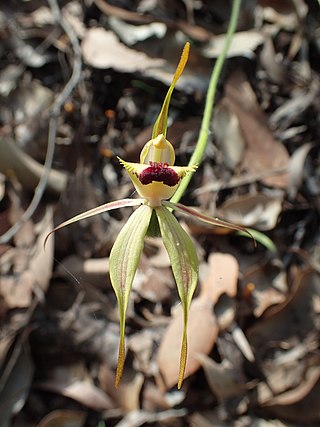
Caladenia rhomboidiformis, commonly known as the diamond spider orchid, is a species of orchid endemic to the south-west of Western Australia. It has a single erect, hairy leaf and one or two green, yellow and red flowers. Until 1971 It was known as a variety of the green comb spider orchid Caladenia dilatata then, until 1989 as a variety of the clubbed spider orchid, Caladenia longiclavata.
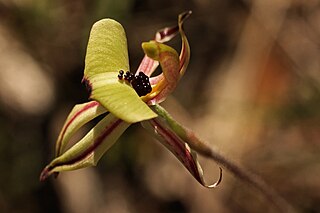
Caladenia roei is a species of orchid endemic to the south-west of Western Australia. It is also known as the common clown orchid, clown orchid, ant orchid, man orchid and jack-in-the-box. It has a single erect, hairy leaf and up to three greenish-yellow and red flowers with a relatively broad labellum. It is a common orchid throughout the south-west and is especially common on granite outcrops.
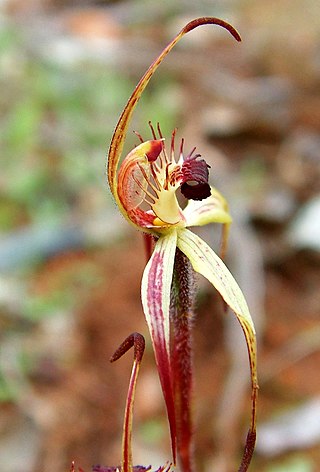
Caladenia williamsiae, commonly known as Judy's spider orchid, or Williams' spider orchid is a species of orchid endemic to the south-west of Western Australia. It is a rare species with a single relatively large, erect, hairy leaf and one or two delicate, greenish-yellow and red flowers. It is only known from a single population near Brookton.
















